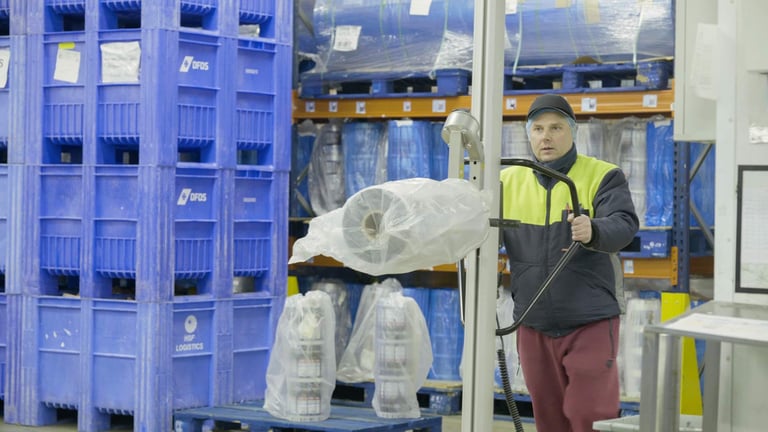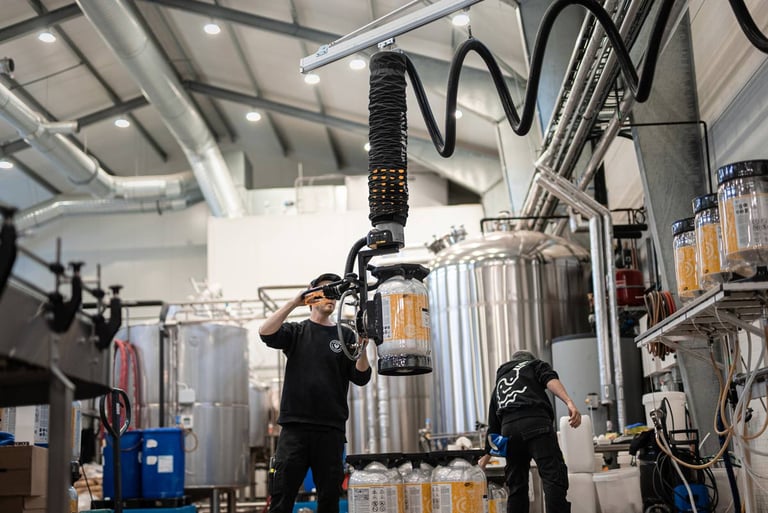The Future of Food & Beverage Material Handling

When people imagine the future, they think of drones, robots, and AI. But what if one of the biggest efficiency gains in your plant doesn’t involve robots taking over, but simply removing manual lifting?
In modern food and beverage production, lifting shouldn't slow you down.
Imagine:
- No more bottlenecks caused by heavy manual lifts
- No more two-person lifts or injury-causing repetitive movements
- A more productive, safer, and happier workforce
Good news, the technology already exists.
Why Manual Lifting Is Still Holding Plants Back
Automation in food and beverage industry is widely used. Most facilities have automated mixers, conveyors, and packaging lines, yet material handling is still manual in many plants.
The hidden cost of “just lifting bags/boxes”
Manual lifting creates:
Risk / Problem Impact on your plant
Injuries (back, shoulder, strains) Lost time, workers comp claims
Human error & variability Inconsistent output, slower cycle time
Two-person lifts needed Higher labour requirements
Fatigue over long shifts Reduced pace + safety risk
Automating lifting tasks protects operations from downtime, standardises production flow and enhances efficiency.
Compared to large automation equipment, ergonomic lifting solutions typically come with a much smaller price tag and short installation time. This allows plants to improve output quickly with minimal disruption.
Manual Lifting = Injuries + Inefficiency
Manual lifting relies on people, and people get tired.

Workers handling heavy or awkward items must repeat the same motions hundreds of times per shift. As fatigue increases, posture worsens, grip weakens, and risk increases.
Common consequences of manual lifting include:
- Strains, sprains, and musculoskeletal disorders (MSDs)
- Back pain and repetitive strain injuries
- Two-person lifts for heavy or bulky items
- Increased absenteeism due to overuse injuries
- Slower throughput as workers tire during the shift
Even if manual lifting looks harmless, it creates inconsistent productivity. The pace at 8:00 AM is not the same pace at 3:00 PM.
Labour Shortages: A Growing Challenge in the Future of Food & Beverage
The food and beverage sector is under pressure to do more with fewer hands.
Data released by the FDA, highlight how dire the labour shortage crisis is. Labour shortages from July 2022–2023 cost the industry an estimated:
- £1.4 billion in reduced output
- £192 million in the final quarter alone
Global factors such as Brexit, the COVID-19 pandemic, and changing workforce demographics have exacerbated these issues. Addressing this challenge is crucial for maintaining the stability and growth of the sector.
Fewer workers + more demand = a widening gap.
Automation in food and beverage industry such as ergonomic lifting solutions help close that gap by:
- Turning two-person lifts into one-person tasks
- Making jobs accessible to a wider range of employees
- Reducing the physical load so workers can stay longer and safer in their roles
- Lifting equipment here doesn’t replace people — it protects them.
The Solution: Smart Lifting
Smart lifting = lifting technology that is ergonomic, hygienic, and fast to implement.
At TAWI, we design smart lifting systems that are simple to use, easy to integrate, and built specifically to remove the physical burden from the operator. Instead of the employee carrying the weight, the lifter does the work — reducing up to 80% of physical strain on the body.
By taking the load, the technology enables one person to safely perform tasks that would traditionally require two workers. This helps to optimise labour and improve workflow. Ergonomic lifting systems maintain a consistent lifting speed throughout the entire shift, ensuring reliable productivity without fatigue-related slowdowns. Their hygienic design makes them ideal for use in food and beverage environments where sanitation and cleanliness are critical.
Capability Snapshot
Lifting Need TAWI Solution
Hygienic-sensitive environments Stainless steel vacuum lifters
Bags, boxes, ingredients, crates Vacuum lifters & lifting trolleys
Quick installation Hours/days, not weeks
Benefits of Modern Lifting Solutions
Introducing ergonomic lifting equipment fundamentally improves how a plant operates. The most immediate benefit is improved employee safety. Manual handling of heavy or repetitive loads causes many strain-related injuries.
The lifter takes the weight, allowing employees to maintain natural posture and safe movement. Reducing the risk of accidents and long-term musculoskeletal issues.
Productivity also increases. Manual lifting is inconsistent and heavily affected by fatigue. Workers begin a shift strong, but speed drops as the day progresses.
TAWI vacuum lifters and lifting trolleys maintain a constant pace from morning to night, hour by hour. Output becomes predictable, and managers can plan production with confidence.
Finally, smart lifting solutions support workforce resilience. When heavy lifting is eliminated, tasks that once required two people can often be performed safely by a single operator. This helps address labour shortages, eases recruitment challenges, and allows existing employees to stay longer in their positions.
Real Customer Result
“The vacuum lifter has greatly improved our work environment since we have eliminated all heavy lifting of kegs. The technical solution is efficient and easy to use. It has also been very reliable.”
Mikael Dugge Engström, Founder & CEO — Dugges Brewery

Dugges Brewery faced a common problem: heavy lifting was slowing production and creating fatigue among operators. Heavy kegs required two people to lift, and repetitive handling created unnecessary strain.
After implementing the TAWI vacuum lifter, the brewery immediately removed heavy lifting of kegs from their workflow. The change improved efficiency, allowed one person to do tasks that previously required two, and created a safer and more satisfying work environment.
Training was quick, the equipment integrated easily into the existing process. Operations became more consistent without slowing down production.
Instead of considering heavy lifting “part of the job,” the team eliminated it entirely.